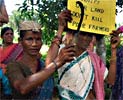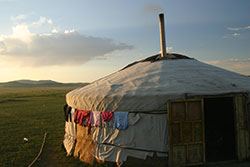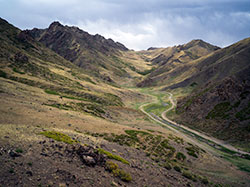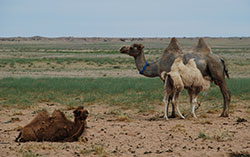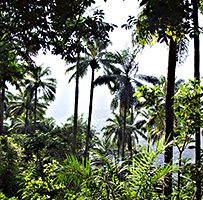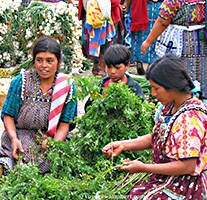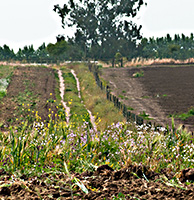Gobi Desert, Mongolia – 2003
Reconciliation
Tonight it is a party night. The family sits together in the yurt, the big, beautifully ornamented nomad tent. There is eating, drinking and laughing, but above all, singing, because a musician is visiting them. And that doesn't happen every day. The musician points toward Ugna, a boy about ten years old. With a lot of devotion he sings a desert song. The musician accompanies him skilfully on his morin khuur, the traditional two-string violin. A while later, when Odgoo, the young mother of Ugna, hands out big bowls of hot tea and chunks of candy, there is a hush for a moment. Then, grandpa Janchiv addresses the guest a bit ceremonially, “We are so grateful that you came to us, and we are so happy that you managed to reconcile the mother and her calf.”
About three weeks ago a little camel was born. It was a difficult, painful delivery, and the camel mother wanted nothing to do with her young one. She didn't allow her to nurse from her. She walked away, snorted, bit and kicked the little one. The young camel bleated in a heart-rending way, but the mother ignored her. Odgoo, her husband, grandpa and grandma, everyone tried anything: soothing and flattering words, different Mongolian prayers and rituals, and tying the mother’s hind legs to prevent kicking. But nothing helped. The camel mother had cast off the young one definitively. Since then, Odgoo had milked the big camel and fed it to the small one. It was a sad spectacle, because the young one went on lamenting.
One evening grandpa said that the Hoosh ritual was the only thing that perhaps could be a solution. But then, you need a morin khuur player, who is not so easily available. For that you have to go all the way to Aimak town. Dude, the big brother of Ugna, travelled two days on his camel through the desert to Aimak, and begged the music teacher of the cultural centre there to help them. The teacher was very busy, but still promised to come.
One week later, he indeed turned up on a motorbike with his instrument. It took the mother camel some time to get used to the musician and the sound of the morin khuur, but then she slowly relaxed – particularly when Odgoo began singing with her splendid voice, putting all her emotions into the song. The big camel began lamenting a bit herself. She glanced at her little one, and stroked her with her head. Some time later, she at last allowed the young one to nurse. Everyone breathed a sigh of relief, and quickly wiped away a tear.
“Yes grandma,” says the musician, “now it is your turn to sing a song.” Grandmother bursts out laughing. “I can't sing at all,” she says shrilly. Then the guest begins a familiar Mongolian melody, and a few moments later everyone is singing with all their hearts.
_______________________
Source
The story of the weeping camel (2003) is a beautiful, quiet movie about nomad life from the Mongolian director Byambasuren Davaa and the Italian Luigi Falorni. The actors play themselves.
Go to:
= the next page: Protection - a small village in Burkina Faso – 2004, story 152.
= the Table of contents, story 151.
